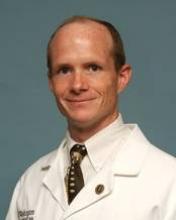Because the likelihood of developing the disease is so high in carriers, their cognitive and brain health can serve as a natural history of the development of AD. By assuming that each person will develop symptoms at or about the same age as did the affected parent, researchers can plot changes that might occur in the years – or even decades – before the disease manifests.
For this analysis, Dr. Bateman and his colleagues examined cerebrospinal fluid (CSF), brain imaging, and cognitive data from 128 participants who had been tracked from the 2009 baseline enrollment through 2010.
There were significant differences between the carriers and noncarriers in every measure investigated, with signs developing up to 25 years before the expected onset of disease.
In cognitive measures, carriers scored significantly lower on the Mini-Mental State Exam starting at 5 years before expected symptom onset, and in delayed recall at 10 years. Noncarriers’ scores remained normal anywhere from 30 years before to 20 years after expected onset. Carriers showed increased atrophy of the bilateral hippocampi, occurring about 15 years before expected onset.
But the differences seen in amyloid deposition and CSF biomarkers most strongly support the amyloid hypotheses. There was no detectable Abeta42 accumulation in the brains of any of the noncarriers. Those who carried the mutation had significant amyloid deposition in the precuneus up to 15 years before the expected onset of AD symptoms. The amount of amyloid increased as subjects approached that time.
Similarly, CSF levels of Abeta42 in carriers decreased as the time of symptom onset approached, indicating that more of the protein was aggregating in the brain. The change was apparent by 10 years before symptom onset. This was accompanied by an increase in CSF tau, a protein that helps stabilize neurons. Its presence in CSF indicates neuronal dysfunction.
Based on these findings, the authors were able to construct a time line of changes that precede the expected time of symptom onset in people with these genetic variants.
CSF biomarkers are the first to change; 25 years before symptoms appear, Abeta42 begins to accumulate in the brain. By at least 15 years before symptoms, imaging will show Abeta42 plaques, and neurons begin to destabilize, increasing CSF tau. Cerebral hypometabolism appears about 10 years before the expected onset of symptoms.
"After these biologic changes, cognitive impairment can be detected, which culminates in clinical impairment and eventually dementia," the investigators wrote. "These findings suggest that the diagnosis of clinical dementia is made late in the course of the biologic cascade of autosomal dominant Alzheimer’s disease."
The results support the hypothesis that inherited AD and the more common sporadic AD may share a common pathophysiological cascade. If this is true, they noted, then the new ability to detect amyloid deposition with brain imaging agents could be much more useful than originally envisioned.
"If autosomal dominant Alzheimer’s disease is similar to late-onset Alzheimer’s disease, this finding suggests that Alzheimer’s dementia will eventually develop in persons with positive scans for amyloid deposition," Dr. Bateman and his associates wrote.
The DIAN study is being funded by the National Institute on Aging. Dr. Bateman and his colleagues disclosed numerous relationships with drug companies conducting Alzheimer’s therapy research. The Icelandic study was sponsored by deCODE Genetics, which employs some of the authors of the study.
A New Era for Alzheimer’s?
When asked to comment on the study results, Dr. Richard J. Caselli, professor of neurology at the Mayo Clinic in Scottsdale, Ariz., said, "Dr. Stefansson and his colleagues show convincingly that individuals with the A673T mutation have a greatly reduced rate of Alzheimer’s development as well as – to a somewhat less-robust degree – slowed cognitive aging even in the absence of Alzheimer’s disease.
"The investigators show the mechanism to be reduced production of amyloidogenic peptides by beta-secretase 1 (BACE1) activity, compared with the wild-type version of the gene. In contrast, the pathogenic A673V variant dramatically increases the amyloidogenic BACE1 products. The authors have essentially discovered nature’s cure for AD, and we can only hope that its pharmacological replication will soon follow," said Dr. Caselli, who is also the clinical core director of the Arizona Alzheimer’s Disease Center.
"The separate report by Dr. Bateman and his colleagues from the Dominantly Inherited Alzheimer Network is another remarkable work," Dr. Caselli continued, "providing unprecedented insight into the sequence of events in the same cohort with regard to biomarkers, imaging, and cognition in advance of symptoms, and using all the tools now in our arsenal: brain imaging, cerebrospinal fluid biomarkers, brain metabolism, and cognitive measures.



